Past Year Questions: Fluid Properties and Manometry | Fluid Mechanics for Civil Engineering - Civil Engineering (CE) PDF Download
Q1: The following figure shows a plot between shear stress and velocity gradient for materials/fluids P, Q, R, S, and T. [2024, Set-II]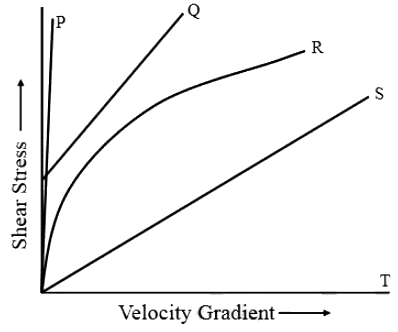
Which one of the following options is CORRECT?
(a) P → Real solid; Q → Newtonian fluid; R → Ideal Bingham plastic; T → Ideal Fluid
(b) P → Ideal Fluid; Q → Ideal Bingham plastic; R → Non-Newtonian fluid; T → Real solid
(c) P → Real solid; Q → Ideal Bingham plastic; S → Newtonian fluid; T → Ideal Fluid
(d) P → Ideal Fluid; Q → Ideal Bingham plastic; R → Non-Newtonian fluid; S → Newtonian fluid
Ans: (c) 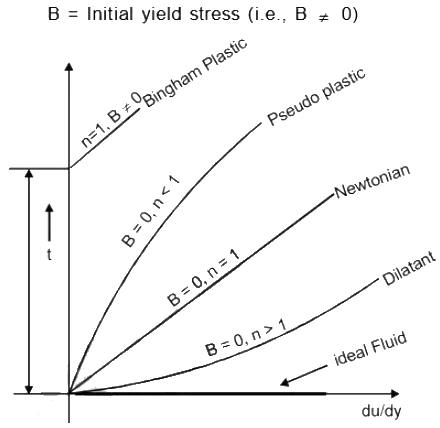 Various types of newtonian & non-newtonian fluids are shown in the figure. Fluids which obeys Newton's law of viscosity
Various types of newtonian & non-newtonian fluids are shown in the figure. Fluids which obeys Newton's law of viscosity are called Newtonian Fluids and those fluids which do not obey this rule are called Non-Newtonian Fluids.
are called Newtonian Fluids and those fluids which do not obey this rule are called Non-Newtonian Fluids.
General relationship between shear stress and velocity gradient is given by
In the figures shown above, slope of the curve is called apparent viscosity.
Fluid for which apparent viscosity increases with du/dy are called Dilatant.
Dilatant fluids are also called shear thickening fluids. Examples of dilatant fluids are solution with suspended starch or sand, sugar in water.
Fluids for which apparent viscosity decreases with du/dy are called Pseudo Plastic.
Pseudo plastic fluid are also called shear thinning fluid. Examples are paints, polymer solutions, blood, paper pulp, syrup, molasses, milk, gelatine.
Bingham Plastic (ideal plastic) fluids require a certain minimum shear stress ty (yield stress) before they start flowing. Examples: tooth paste, sewage sludge, drilling mud have time dependent Newtonian Behaviour.
Q2: The pressure in a pipe at X is to be measured by an open manometer as shown in figure. Fluid A is oil with a specific gravity of 0.8 and Fluid B is mercury with a specific gravity of 13.6. The absolute pressure at X is kN/m2 (round off to one decimal place). [Assume density of water as 1000 kg/m3 and acceleration due to gravity as 9.81 m/s2 and atmospheric pressure as 101.3kN/m2] [2023, Set-II] Ans: 140 to 141
Ans: 140 to 141 Equating pressure at A- A'
Equating pressure at A- A'
= 140.54kN/m2
Q3: A three-fluid system (immiscible) is connected to a vacuum pump. The specific gravity values of the fluids (S1, S2) are given in the figure. [2018, Set-II]
The gauge pressure value (inkN/m2, up to two decimal places) of p1 is ______
(a) -8.73
(b) -4.78
(c) -2.54
(d) 0
Ans: (a) Taking P1 is in gauge pressure.
Taking P1 is in gauge pressure.
PA = P1 + 0.88 × 103 ⋅(9.81)(0.5) + (0.95 × 103)(9.81)(1)
103 (9.81)(0.5) = P1 + (0.88 × 103)⋅(9.81)(0.5) + (0.95 × 103)(9.81)(1)
P1 = −8.73kN/m2
Q4: A closed tank contains 0.5 m thick layer of mercury (specific gravity = 13.6) at the bottom. A 2.0 m thick layer of water lies above the mercury layer. A 3.0 m thick layer of oil (specific gravity = 0.6) lies above the water layer. The space above the oil layer contains air under pressure. The gauge pressure at the bottom of the tank is 196.2 kN/m2. The density of water is 1000 kg/m3 and the acceleration due to gravity is 9.81 m/s2. The value of pressure in the air space is [2018 : 2 Marks, Set-I]
(a) 92.214 kN/m2
(b) 95.644 kN/m2
(c) 98.922 kN/m2
(d) 99.321 kN/m2
Ans: (a)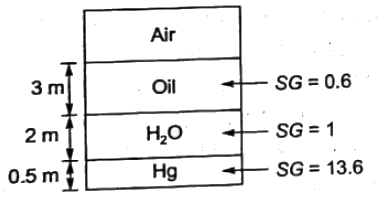

Note: It is a closed chamber, hence concept of absolute pressure cannot be applied.
Calculations have to be done in the form of gauge pressure.
Q5: The figure shows a U-tube having a 5 mm x 5 mm square cross-section filled with mercury (specific gravity = 13.6) up to a height of 20 cm in each limb (open to the atmosphere).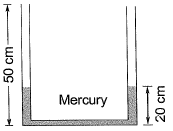 If 5 cm3 of water is added to the right limb, the new height (in cm, up to two decimal places) of mercury in the Left limb will b e __________ . [2017 : 2 Marks, Set-II]
If 5 cm3 of water is added to the right limb, the new height (in cm, up to two decimal places) of mercury in the Left limb will b e __________ . [2017 : 2 Marks, Set-II]
Ans: Volume of water added = 5 cm3
Cross-section of U tube
= 5 mm x 5 mm = 0.25 cm2
Height of water column in U tube

Now due to conservation of volume, rise in left limb will be equal to fall in right limb.
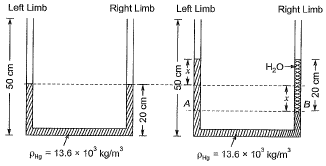

So, the new height (in cm to two decimal place of mercury in the left limb will be)
= 20 + 0.74 = 20.74 cm
Q6: Group I contains the types of fluids while Group II contains the shear stress-rate of shear relationship of different types of fluids, as shown in the figure

The correct match between Group I and Group II is [2016 : 1 Mark, Set-II]
(a) P-2, Q-4, R-1, S-5
(b) P-2, Q-5, R-4, S-1
(c) P-2, Q-4, R-5, S-3
(d) P-2, Q-1.R-3, S-4
Ans: (c)
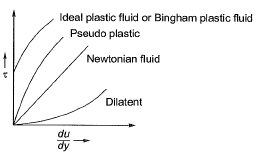
Fluid Types (Group I) Overview:
Newtonian Fluid (P):
Linear relationship between shear stress and rate of shear
Passes through the origin
Example: Water, air
Graph: Straight line, constant slope
→ Curve 2
Pseudo Plastic Fluid (Q):
Shear-thinning behavior: viscosity decreases with increased shear rate
Non-linear curve, starts steep and flattens
→ Curve 4
Plastic Fluid (R):
Needs a yield stress to start flowing
Behaves like a solid until yield stress is exceeded
After yield, may behave like Newtonian or non-Newtonian
→ Curve 5 (shows yield stress before flow)
Dilatant Fluid (S):
Shear-thickening behavior: viscosity increases with increased shear rate
Becomes thicker under shear
→ Curve 3
Q7: The dimension for kinematic viscosity is [2014 : 1 Mark, Set-I]
(a) 
(b) 
(c) 
(d) 
Ans: (c)
The SI unit of kinematic viscosity is m2/s
∴ Dimension of kinematic viscosity [v]=L2/T.


|
54 videos|141 docs|115 tests
|
FAQs on Past Year Questions: Fluid Properties and Manometry - Fluid Mechanics for Civil Engineering - Civil Engineering (CE)
| 1. What are the key properties of fluids that affect their behavior in manometry? |  |
| 2. How does a manometer work to measure fluid pressure? |  |
| 3. What types of manometers are commonly used in fluid mechanics? |  |
| 4. How do temperature and fluid properties affect manometer readings? |  |
| 5. What are common mistakes to avoid when using a manometer for fluid pressure measurement? |  |

















